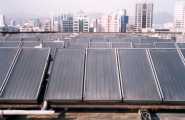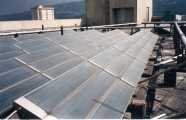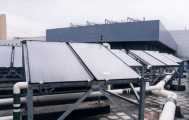[Hui, S. C. M., 2000. Solar Hong Kong - present applications
and future prospects, Renewable Energy World, 3 (1): 76-83, January
2000.]
Solar Hong Kong - present applications
and future prospects
|
 Hong Kong is a high-rise
and high-density city with a subtropical climate. In mid-1999, it has a
population of 6.84 millions and an area of only 1,097 square kilometres.
It does not have any indigenous fossil resources and depends entirely on
imported fuels, including coal, natural gas and oil, for energy generation.
Hong Kong is a high-rise
and high-density city with a subtropical climate. In mid-1999, it has a
population of 6.84 millions and an area of only 1,097 square kilometres.
It does not have any indigenous fossil resources and depends entirely on
imported fuels, including coal, natural gas and oil, for energy generation.
At present, Hong Kong does not as yet make significant use of renewable
resources to meet its energy needs. Lack of incentives and shortage of
land and space are the key factors limiting the deployment of renewable
energy systems (Hui, Cheung and Will, 1997). Large
hydropower, traditional biomass and geothermal energy are not feasible
in Hong Kong because of the local conditions and resources. Only a few
projects in Hong Kong now have extensively adopted some forms of renewable
energy, such as solar water heating.
Nevertheless, with growing concerns about energy and the environment,
Hong Kong has been working hard in the past decade to develop energy efficiency
programmes and to find ways to minimise the environmental impact of energy
production and use (ESB, 1998). There is a need in
Hong Kong to establish a renewable energy market so as to satisfy the local
demand for green energy and create business opportunities for promoting
renewable energy in mainland China (Hui, 1997). Solar
energy systems, such as solar thermal and photovoltaics, are believed to
be one of the potential areas for future development. Under the Hong Kong's
urban context, technologies that can be integrated into a built environment
with high-rise buildings are important. Countrysides and new towns in Hong
Kong are also potential candidates for renewable energy systems.
| 2. Solar
and Weather Conditions |
The solar and weather data provide an important background for assessing
the solar potential and the characteristics of energy use in buildings.
Table 1 shows the solar conditions in Hong Kong (HKO,
1999). The annual mean daily global solar radiation is 14.46 MJ/m2.
Compared with a figure of around 9 MJ/m2 in London, this is
not bad at all. If we look at the cloud amount and percentage of sunshine,
the data indicates that cloudiness in some months may affect directional
solar radiation. Diffuse component of the solar radiation becomes significant,
especially in months from February to June.
Table 1. Solar conditions in Hong Kong
| |
Jan |
Feb |
Mar |
Apr |
May |
Jun |
Jul |
Aug |
Sep |
Oct |
Nov |
Dec |
Year |
| GSR |
11.63 |
10.69 |
11.24 |
13.14 |
16.12 |
16.55 |
19.15 |
17.61 |
16.49 |
15.46 |
13.39 |
12.03 |
14.46 |
| % sunshine |
45 |
30 |
26 |
29 |
38 |
40 |
56 |
52 |
49 |
54 |
55 |
54 |
44 |
| Cloud % |
58 |
73 |
76 |
78 |
74 |
75 |
65 |
66 |
63 |
56 |
53 |
49 |
65 |
Note: GSR = mean daily global solar radiation (MJ/m2);
% sunshine = percentage of possible bright sunshine (%); Cloud % = Cloud
amount (%)
Table 2. Average temperature and humidity in
Hong Kong
| |
Jan |
Feb |
Mar |
Apr |
May |
Jun |
Jul |
Aug |
Sep |
Oct |
Nov |
Dec |
Year |
| DBT |
15.8 |
15.9 |
18.5 |
22.2 |
25.9 |
27.8 |
28.8 |
28.4 |
27.6 |
25.2 |
21.4 |
17.6 |
23.0 |
| % RH |
71 |
78 |
81 |
83 |
83 |
82 |
80 |
81 |
78 |
73 |
69 |
68 |
77 |
Note: DBT = dry bulb temperature (oC); %
RH = relative humidity (%)
Average temperature and humidity in Hong Kong are given in Table 2.
With an annual dry-bulb temperature of 23.0 oC, the heating
demand in most buildings in Hong Kong is not significant. The cooling requirements
is large in the summer period which lasts from May to October. The humidity
level remains high in months from February to September and this presents
a need for dehumidification or sufficient ventilation in most buildings
in order to maintain human comfort.
In Hong Kong, utilisation of solar energy for domestic, commercial and
industrial purposes is affected by the following factors (Hong
Kong Government, 1985):
-
High-rise buildings and high population density make it difficult to find
suitable locations for solar collectors and equipment.
-
As the demand for heating energy is relatively low in many buildings, the
economic advantage of directly using solar heat is weakened.
-
The requirement of strong anchorage to withstand high gales in the typhoon
season adds extra costs to the solar energy installation.
-
In the absence of a local equipment industry, the majority of the equipment
has to be imported from overseas and the price of the equipment is high
compared with the potential saving.
-
Building developments in Hong Kong are usually fast track and demand quick
returns on investment. This creates barriers to solar systems which often
require much time to design and have a longer payback period.
As the energy price in Hong Kong is very low compared with the land and
construction costs, the developers and building owners lack the incentive
to use solar energy systems. With a small number of applications and limited
market, the possible economics of scale cannot be achieved at present and
the awareness and knowledge for the technology are comparatively low.
Despite of the difficulties mentioned before, the Hong Kong Government
has tried to use and explore solar energy systems in their premises since
1980. The purpose is to collect performance data and build up experience
from the completed installations before the economic advantage of the solar
systems can be justified in a business environment. In recent years, a
few large-scale projects for solar thermal systems have been completed
to demonstrate the importance of such applications and to change people's
general attitudes.
| 4. Solar
Thermal Applications |
Solar thermal systems using sunlight to heat water directly or indirectly
have been installed in nine government premises with a total solar collection
area of over 1,700 m2. These premises include public bathhouses,
prison (for kitchen and laundry equipment), military camp, swimming pool
complex, hospital, and a new slaughterhouse. The major functions of hot
water produced by solar heating are for bathing, pool heating and pre-heating
of boiler feed water. The estimated payback periods vary from 6 to 27 years
depending on the usage of the systems. Table 3 shows a list of the large-scale
solar thermal applications in Hong Kong. Most of them are government projects
installed in rural areas or new towns, since it is difficult to find suitable
locations in urban areas.
Table 3. Examples of large-scale solar thermal
applications in Hong Kong
|
Year completed
|
Location
|
System description
|
|
1978
|
A hotel and office complex in Tsimshatsui facing Victoria Harbour (*
by a private developer) |
280 nos. of flat-plate collectors each 900 mm x 2130 mm
  |
|
1983
|
A drug addiction treatment centre on a remote island (Hei Ling Chau) |
400 m2 of flate-plate collectors and two 16,000 litre solar
water storage tanks |
|
1983
|
A prison on Lantau Island (Shek Pik) |
450 m2 of flate-plate collectors and five calorifiers of
capacity 36,400 litres |
|
1994
|
A hospital in a new town (Tuen Mun) |
96 m2 of solar panels designed to serve a hydrotherapy pool
  |
|
1998
|
A swimming pool complex in a town area (Kwai Chung) |
168 nos. of solar panels with total 330 m2 to support swimming
pool heating
   |
|
1999
|
A new slaughterhouse in rural area (Sheung Shui) |
450 nos. of solar panels to provide hot water for processes
  |
Experience showed that putting solar installation into a new building
usually is more favourable than retrofitting an existing building because
the cost of retrofitting in framing and plumbing may be much as the cost
of the collectors for a small project. Sizing the pipework and circulating
pump accurately can reduce the operating cost. To avoid waste of thermal
energy, insulation should be designed properly. Proper operation and maintenance
of the installation are critical to generating of energy and cost savings
from the system.
Apart from government projects, a few private buildings in Hong Kong
have tried to install solar thermal systems for generating hot water. Their
considerations for economic justification are important and this is usually
met by matching solar heat with sufficient hot water demand, such as in
hotels and youth hostels.
To improve the efficiency of the system, other measures or technologies
may be utilised to compliment the solar heat, such as the use of heat pump
or heat recovery systems to reclaim heat from the air-conditioning plant
so as to raise water temperature in the hot water system (see Figure
1). An integrated approach to designing of the building energy systems
is important for achieving an optimal design solution which minimises total
non-renewable energy use. A careful understanding of the cooling and heating
demands is necessary for designing and matching the system components.
This will help lower the capacity and initial investment of the systems.

Figure 1. Solar thermal system integrated with heat pump chiller
for hot water generation
The use of photovoltaic (PV) systems to generate electricity is another
option now being discussed and investigated in Hong Kong. PV system has
been used effectively in remote-site applications. For example, at present,
about 60% of the major battery-operated aids to navigation in Hong Kong
waters are powered by solar energy so as to reduce refuelling costs. PV
panels also provide power to the equipment in the Tai Mo Shan radar station
which is a weather observation point on top of the mountain. Many other
automatic weather stations are using PV cells to support their operation.
A pilot scheme on a PV system for lighting has been carried out in the
Kowloon Walled City Park which is a public park located in the middle of
the city. Other PV applications are being investigated in some research
projects of the local universities. Unlike western countries, PV applications
on rooftop and open space are limited in Hong Kong, except for a few rural
areas. Effective strategy and technology are needed to apply PV in the
urban environment so that high-rise buildings in Hong Kong could benefit
from renewable energy supply.

A weather station powered by photovoltaic panel |

PV research at a university in Hong Kong (Photo: H X
Yang) |
The concept of building-integrated photovoltaic (BIPV) system is believed
to be a potential area for solar applications in Hong Kong because it can
fit PV cells or panels into the building components such as building facade,
shading device and roof. By combining the functions of the PV panels, the
overall investment of the system can be reduced significantly. To put this
concept into practice, the Hong Kong Government is planning in the year
2000/2001 to install PV systems on two government office buildings which
have curtain wall construction in their building facades. The electricity
from the PV panels will meet part of the electrical energy demands of the
buildings.
As the costs and space for battery storage often create difficulties
to PV system design, pilot research is being carried out to investigate
how grid-connected PV systems can be used in Hong Kong to eliminate the
need for battery storage. Connecting PV or other renewable energy systems
to the electricity grid requires the cooperation of the power companies.
Current electricity regulations and the control scheme between the Government
and power companies will have to be reviewed so as to arrange for effective
power generation, distribution and purchasing. The possible control problems,
local pollution and the effective use of land have to be considered when
making the final decision.
The Government's commitment is critical for the development and implementation
of solar energy systems in Hong Kong since there are various institutional
and technical barriers in the free-market business environment that prevent
the renewable energy industry from growing easily by itself. With a vision
to achieve sustainable development in Hong Kong for the 21st century, the
Government has carried out studies and considered ways to improve urban
environment and make better use of resources (Planning
Department, 1999).
Among the various agenda items, renewable energy is one of the key issues
that most people agreed to pursue unanimously. The major question at this
point is to investigate the most suitable renewable energy for Hong Kong
and build up skills and experience for its development, design and operation.
Bear in mind the social and economic conditions of Hong Kong, it is important
to recognise that solutions to the energy problems are not simply a matter
of applying technology and enforcement through legislation. It requires
public awareness and participation as well. Therefore, measures to promote
public awareness and education are crucial for the implementation of the
renewable energy policy.
| 7. Relationship
with Mainland China |
One very important thing is the Hong Kong's relationship with mainland
China and its implications to renewable energy development (Hui
and Cheung, 1998). If Hong Kong, in pursuit of renewable energy, could
adopt an integrated approach through collaboration with Southern China
(such as Guangdong) which has abundant renewable energy resources and land,
then the cross-boundary cooperation would bring about greater benefits
to both sides. As the electricity transmission system of Hong Kong is interconnected
with the Guangdong Province in the mainland China, it is possible for Hong
Kong to make use of the mainland's renewable energy resources to meet its
energy need in an environmental friendly and sustainable way.
It is clear that China is keen to develop renewable energy (Lindley,
1998). For example, in the coming years, the largest solar product
manufacturing plant in China will be built in Shenzhen (through joint venture
with a French company). If Hong Kong could play an active role in promoting
renewable energy development in mainland China, such as by serving as a
financial intermediary and an information and technology gateway, then
good business opportunities and industrial development may be generated.
An interesting example of such collaboration is a "solar-powered air-conditioning"
project in Jiangmen City, near Guangzhou in southern China (Wolin,
1998). A university professor from Hong Kong has been the project leader
working with colleagues at Guangzhou Institute of Energy Conversion to
design and implement this innovative project.
It will take time to evaluate the potential of active solar energy systems
in Hong Kong and develop cost-effective strategies for large-scale and/or
commercialized application. In short term, these systems are unlikely to
spread widely in Hong Kong and the energy saving methods will continue
to be the main focus for improving energy efficiency in buildings. Measures
like passive solar design, passive cooling, shading and sun control, ventilation
strategy, use of natural sunlight, energy efficient lighting and air-conditioning
should be fully explored.
In medium to longer term, solar thermal and photovoltaics should play
a more important role in meeting Hong Kong's energy demand. Opportunities
in other renewable areas such as wind energy, small hydro, solar hydrogen,
and biomass should be evaluated to identify potential niche markets for
their application. Knowledge and skills about the renewable energy systems
is useful for promoting them in mainland China, even though they might
not be applied in Hong Kong.
Another related area is the Asia's largest refuse incinerator that the
Hong Kong Government is planning to build in the coming years. Although
the purpose of the incinerator is to reduce the volume of waste in Hong
Kong, useful heat/electricity can be produced by the waste-to-energy facilities.
Experience in USA and Europe indicates that the role of utility companies
is quite important for renewable energy deployment. With a world-wide trend
for utility deregulation, it is necessary to review and redefine the role
of Hong Kong's utility companies so that, instead of creating barriers
to private renewable generation, they could make active contribution to
the "solar business" in the energy market.
Solar energy has definite possibilities in Hong Kong since there is abundant
sunlight. High-rise and high-density urban environment create difficulties
to solar energy applications. Current business practices do not favour
renewable energy and the Government's role is critical for stimulating
the market. Although current applications (solar thermal and photovoltaics)
are small in number, they can provide valuable information and draw people's
attention to the technology.
Interesting suggestions for using solar systems have been raised in
the community. For example, it was suggested to build solar and wind energy
systems in the "Hong Kong Disneyland"; a holistic approach for designing
solar systems in the new towns was proposed; highways and tunnels may be
lit and ventilated by a renewable source of energy; solar-powered streetlight
systems may be widely adopted. More research and innovation are needed
to examine and identify suitable design options. Partnership between Hong
Kong and mainland China will open up a new era for achieving sustainable
energy development.
-
ESB, 1998. Energy Policy from an Environmental Perspective,
Economic Services Bureau (ESB), Hong Kong, "http://www.pelb.wpelb.gov.hk/ace/ace/paper48.htm".
-
HKO, 1999. Monthly Meteorological Normals and Extremes
for Hong Kong, Hong Kong Observatory (HKO), "http://www.info.gov.hk/hko/wxinfo/climat/normals.htm".
-
Hong Kong Government, 1985. The progress and development
of solar energy in Hong Kong, In Proc. of the Regional New and Renewable
Sources of Energy Development Programme for Asia and Pacific, November
1985, Bangkok, published by United Nation.
-
Hui, S. C. M., 1997. From
renewable energy to sustainability: the challenge for Hong Kong, In
Proc. of the POLMET '97 Conference, 25-27 November 1997, Hong Kong
Institution of Engineers, Hong Kong, pp. 351-358.
-
Hui, S. C. M. and Cheung, K. P., 1998. The
role of Hong Kong in the development of renewable energy in China,
In Proc. of the World Renewable Energy Congress V, 20-25 September
1998, Florence, Italy, pp. 2571-2574.
-
Hui, S. C. M., Cheung, K. P. and Will, B. F., 1997.
Renewable energy in Hong Kong and Mainland China, Sun At Work in Asia-Pacific,
Number 1, Autumn 1997, pp. 27-30.
-
Lindley, D., 1998. An overview of renewable energy
in China, Renewable Energy World, Vol. 1, No. 3, November 1998,
pp. 65-69.
-
Planning Department, 1999. Study on Sustainable
Development for the 21st Century, Planning, Environment and Lands Bureau,
Hong Kong, "http://www.info.gov.hk/planning/susdev/venue-e.htm".
-
Wolin, M. L., 1998. Cooling down, Far Eastern Economic
Review, Vol. 161, Iss. 41, October 8, 1998, pp. 80.
 Hong Kong is a high-rise
and high-density city with a subtropical climate. In mid-1999, it has a
population of 6.84 millions and an area of only 1,097 square kilometres.
It does not have any indigenous fossil resources and depends entirely on
imported fuels, including coal, natural gas and oil, for energy generation.
Hong Kong is a high-rise
and high-density city with a subtropical climate. In mid-1999, it has a
population of 6.84 millions and an area of only 1,097 square kilometres.
It does not have any indigenous fossil resources and depends entirely on
imported fuels, including coal, natural gas and oil, for energy generation.











